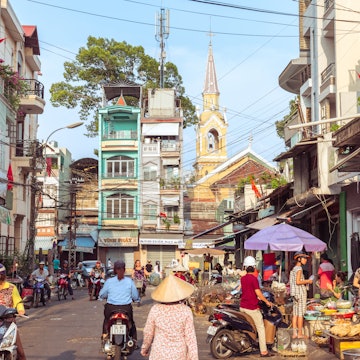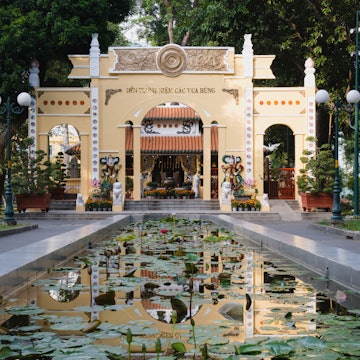

The waterfront in the historic town of Hoi An, Vietnam. saiko3p/Shutterstock
With its tumbling emerald landscapes, history-steeped ancient sites, idyllic beaches and energetic cities, Vietnam is a magnet for visitors in search of an incredible travel experience. More and more visitors are going there every year, often following the same well-trodden path.
With blissful sands, Cham-era ruins and two of Asia's liveliest megacities, it pays to plan your trip around the places you absolutely can't miss. Where you want to go will influence whether you fly into cultured Hanoi in the north or busy Ho Chi Minh City (HCMC) in the south, or whether you bypass these two mighty metropolises for the laid-back beaches of tropical Phu Quoc or majestic mountains of Ha Giang.
Start your travel planning now with our pick of Vietnam's unmissable cities, beaches, islands and national parks.

1. Phu Quoc
Best for beach lovers
About as far south as you can get from Hanoi without splashing into the Gulf of Thailand, the island of Phu Quoc is where beach worshippers come to pray. Lapped by jewel-blue waters and edged by fine sandy beaches, this is a place to slip into low gear, reaching for a cocktail as the ember-colored sun dips into the bay.
But it's far from undiscovered – local tourists come in droves for theme park thrills at VinWonders and giddying views over the sea from the world's longest over-sea cable car at the Sun World Hon Thom nature park. Phu Quoc is a popular stop for families, and if you fancy a change from the tourist scene, there are dense jungles to explore inland from the sand.
Planning tip: If you're bound for Phu Quoc, there's no need to go via Hanoi and HCMC. Numerous Asian airlines offer flights directly to Phu Quoc from hubs such as Bangkok, Kuala Lumpur and Seoul, connecting with long-haul flights further afield. Also note that normal visa requirements are suspended for Phu Quoc – visitors can stay visa-free for up to 30 days.
2. Hanoi
Best for first-time visitors
Every trip has to start somewhere, and the ideal point of arrival for first-timers is Vietnam's historic capital. As well as easy infrastructure, inexpensive accommodations, world-class dining and more history than you'll ever have time to take in, Hanoi is the leaping-off point for the islands and outcrops around Halong Bay and the forest-draped trails of the mountainous northwest.
The city has many fantastic experiences, but be sure to give yourself time to graze through Vietnam's catalog of street food treats and pause to soak up the atmosphere in cozy cafes in the Old Quarter.
Planning tip: To enjoy Hanoi nightlife on a budget, swing by the streetside bia hoi (draft beer) stalls at busy Bia Hoi Junction on the drinking strip of P Ta Hein.

3. Lan Ha Bay and Bai Tu Long Bay
Best for iconic photos
Things can get pretty cramped in crowded Halong Bay, but the shimmering bays to the north and south have a more peaceful air and a similarly spectacular collection of karst outcrops and islands. While trips to Halong Bay are highly commercialized, with motorized luxury junks blowing diesel fumes around the eroded karst formations, in Lan Ha Bay and Bai Tu Long Bay you won't have quite so many cruise ships in your photos.
Try kayaking between the outcrops, explore the tropical trails on Cat Ba Island – gateway to Lan Ha Bay – or kick back on the sand on Bai Tu Long's idyllic Co To Island, with its collection of pretty beaches and seafood restaurants.
Planning tip: If you visit Cat Ba Island, take time to explore the trails around Cat Ba National Park – if you trek with your own guide, it's easy to leave the crowds behind.
4. Ho Chi Minh City
Best for nightlife
Cosmopolitan, French-flavored Ho Chi Minh City (HCMC) is the southern counterweight to Hanoi in the north, taking its cultural cues from the Mekong Delta and neighboring Cambodia. It's fast-paced, frenetic and fun, particularly after dark, when the pavements transform into a mobile buffet of street food stalls and roadside bars.
A little of the frontier feel of the war years lives on in HCMC, and you can learn more about this troubled period in Vietnamese history at sites such as the War Remnants Museum. The ghosts of French Indochina linger too – set aside some time to wander past the city's colonial-era landmarks, then settle into a coffee shop with a cup of ca phe – drip-brewed Vietnamese coffee.
Planning tip: For a break from the city crush, swing out to nearby Tay Ninh, where the Cao Dai Holy See offers a fascinating introduction to the all-embracing Cao Dai religion.

5. Phong Nha-Ke Bang National Park
Best for unique experiences
Vietnam's biggest natural attraction – literally – is Hang Son Doong Cave, the largest cavern in the world by volume and a true natural wonder. An entire New York City block could fit inside its vast main passage, but visitor numbers are strictly controlled and this monster cavern is only accessible on costly guided treks, which are already booked up for 2026.
The good news is that Phong Nha-Ke Bang National Park is pockmarked with numerous other caverns that you can clamber, crawl, boat or zipline through for a fraction of the cost. Trips to the Tu Lan, Phong Nha and Paradise caves are possible on a shoestring budget; more cash will buy access to Hang En, where trekkers set up tents on an underground beach, illuminated by shafts of natural light.
6. Hoi An
Best for history
A stay in harmonious Hoi An is a journey into Vietnam's lavish, layered past. This was once one of the most important ports in Asia, and traders from as far as Japan, Spain and North America filled the pockets of its merchants with gold. Locals used their money wisely, packing the Old Town with tidy shophouses, tea warehouses, fanciful covered bridges, elaborate Chinese-style guildhalls and colorful Confucian and Buddhist pagodas.
History is only the beginning in Hoi An. Many travelers stay for days, learning to make white rose dumplings and summer rolls on chef-led cooking courses, and ordering made-to-measure suits and gowns from the city's modestly priced tailors' shops.
Planning tip: For a change of pace, head inland from Hoi An and spend a night in a friendly community homestay in the Co Tu minority village of Bho Hoong.

7. Ha Giang
Best for mountain views
Trekking to minority villages in the hills around Sapa is one of Vietnam's top draws, but the country's trekking capital feels rather commercialized these days. Hikers have to walk further every year to find the rural idyll that first drew people to the country's mountainous northwest.
For scenic countryside without the company, remote Ha Giang province is Vietnam's new frontier. Staying in simple village homestays, you can hike out to minority villages and rice terraces tucked between the soaring limestone peaks, and motor (or pedal) over some of Vietnam's most spectacular passes. You'll want to take plenty of photos on the winding mountain road between Ha Giang town, Dong Van and Meo Vac.
Planning tip: If you're confident and experienced, motorcycles and scooters can easily be rented in Ha Giang town for exploring the hills. Be aware that you'll need an international driving license (and a home license covering motorcycles if you plan to rent a motorcycle rather than a scooter). You can also book a tour or a local guide who will drive you through the highlights.
8. The Central Beaches
Best for sun-seekers
Sandy bays stud Vietnam's central coastline, but the mood varies widely from beach to beach. Package tourists flock to high-rise Danang and Nha Trang, famed as a military R&R stop during the American War, but more interesting for its buzzing beach scene, Cham-era ruins, Buddhist shrines and delectable seafood.
We rate the calmer beaches along the coast, where Vietnam's old seaside charm endures. To the south of Nha Trang, Mui Ne is a lively kitesurfing hub spanning a string of sandy coves, while Doc Let Beach to the north serves up 18km of sand, surf and seafood.
Detour: For a quieter beach experience, hit the coast between Hue and Danang – Thuan An is the gateway to a string of serene and sandy beaches flanking a lagoon-backed barrier island.

9. Hue
Best for imperial history
The former capital of the Nguyen dynasty – which ruled over large parts of Vietnam, Laos and Cambodia in the 19th and 20th centuries – drips with imperial history, despite the ravages of US bombers during the American War.
Much was lost in Hue, but the grandeur of dynastic Vietnam lives on in the Citadel and Imperial Enclosure, housing the emperor's residence, temples, palaces and court. At one time, entering without imperial compound permission would bring instant death.
Just outside town are the tombs of Vietnam's greatest emperors, resting serenely in green compounds beside the Perfume River. Another relic of royal rule is Hue's imperial cuisine – arguably the finest in the country. Try a spicy bowl of bun bo Hue (vermicelli noodle soup) or a crispy banh khoai pancake, and you'll see what we mean!
Planning tip: To stay one step ahead of the crowds at Hue's imperial tombs, rent a motorcycle or scooter to explore; don't miss the Thien Mu Pagoda on your way out of the city.
10. Ba Be National Park
Best for lake and forest scenery
Vietnam has more than 30 national parks, taking in everything from coastal swamps to mountain jungles, but some are firmly on the tourist trail, and the crowds can be an impediment to spotting wildlife. That's less of a problem in lovely Ba Be National Park, where trails weave between the limestone peaks to Hmong, Tay and Dzao villages, and boat and kayak trips cross serene lakes hemmed in by forested ridges, creating scenes worthy of a medieval woodcut.
Keep an eye out for wildlife while you explore. The park is a haven for everything from macaques and langur monkeys to rare black bears, scaly pangolins and the spectacular crested serpent eagle.
Planning tip: Comfy accommodation in village homes completes the sense of stepping off the mainstream tourist circuit. For an intimate homestay experience, check out the family-run guesthouses in Pac Ngoi village, accessible by bus from Hanoi, via the village of Cho Don.
















